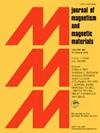Structural and magnetic properties of rapidly solidified and Bi-bonded hot compacted Mn53.3−xAl45C1.7Tix magnets
IF 2.5
3区 材料科学
Q3 MATERIALS SCIENCE, MULTIDISCIPLINARY
引用次数: 0
Abstract
This study examines the impact of Ti doping on the phase formation and magnetic properties of Mn–Al–C alloys. Using melt spinning, we synthesized MnAl45C1.7Ti alloys (x values ranging from 0 to 1.5) producing high purity -phase ribbons. The optimal annealing treatment for the formation of ferromagnetic -phase is 20 min at 550 °C for all compositions. However, Ti-doped samples showed the formation of -phase due to partial phase decomposition, and TiC precipitates were present at high Ti concentrations. Upon doping, the Curie temperature was increased from 557K (Ti free sample) to 600K. To improve the coercivity, a combination of ball milling and hot compaction, introducing Bi as a metallic binder, have resulted in increased coercivity from 0.18 T to 0.33 T. Bi addition lead to formation of a grain boundary phase aiding densification. We demonstrate how modifying composition and processing can improve the magnetic properties of Mn–Al based magnets.
快速凝固和双键热压实 Mn53.3-xAl45C1.7Tix 磁体的结构和磁特性
本研究探讨了掺杂 Ti 对 Mn-Al-C 合金的相形成和磁性能的影响。我们采用熔融纺丝法合成了 Mn53.3-xAl45C1.7Tix 合金(x 值范围为 0 至 1.5),并生成了高纯度的ϵ相带。对于所有成分,形成铁磁性τ相的最佳退火处理是在 550 ℃ 下退火 20 分钟。然而,掺杂钛的样品由于部分相分解而形成了β相,并且在钛浓度较高时出现了 TiC 沉淀。掺杂后,居里温度从 557K(无钛样品)升至 600K。为了提高矫顽力,我们结合球磨和热压,引入 Bi 作为金属粘合剂,使矫顽力从 0.18 T 提高到 0.33 T。我们展示了改变成分和加工过程如何改善锰铝基磁体的磁性能。
本文章由计算机程序翻译,如有差异,请以英文原文为准。
求助全文
约1分钟内获得全文
求助全文
来源期刊

Journal of Magnetism and Magnetic Materials
物理-材料科学:综合
CiteScore
5.30
自引率
11.10%
发文量
1149
审稿时长
59 days
期刊介绍:
The Journal of Magnetism and Magnetic Materials provides an important forum for the disclosure and discussion of original contributions covering the whole spectrum of topics, from basic magnetism to the technology and applications of magnetic materials. The journal encourages greater interaction between the basic and applied sub-disciplines of magnetism with comprehensive review articles, in addition to full-length contributions. In addition, other categories of contributions are welcome, including Critical Focused issues, Current Perspectives and Outreach to the General Public.
Main Categories:
Full-length articles:
Technically original research documents that report results of value to the communities that comprise the journal audience. The link between chemical, structural and microstructural properties on the one hand and magnetic properties on the other hand are encouraged.
In addition to general topics covering all areas of magnetism and magnetic materials, the full-length articles also include three sub-sections, focusing on Nanomagnetism, Spintronics and Applications.
The sub-section on Nanomagnetism contains articles on magnetic nanoparticles, nanowires, thin films, 2D materials and other nanoscale magnetic materials and their applications.
The sub-section on Spintronics contains articles on magnetoresistance, magnetoimpedance, magneto-optical phenomena, Micro-Electro-Mechanical Systems (MEMS), and other topics related to spin current control and magneto-transport phenomena. The sub-section on Applications display papers that focus on applications of magnetic materials. The applications need to show a connection to magnetism.
Review articles:
Review articles organize, clarify, and summarize existing major works in the areas covered by the Journal and provide comprehensive citations to the full spectrum of relevant literature.
 求助内容:
求助内容: 应助结果提醒方式:
应助结果提醒方式:


